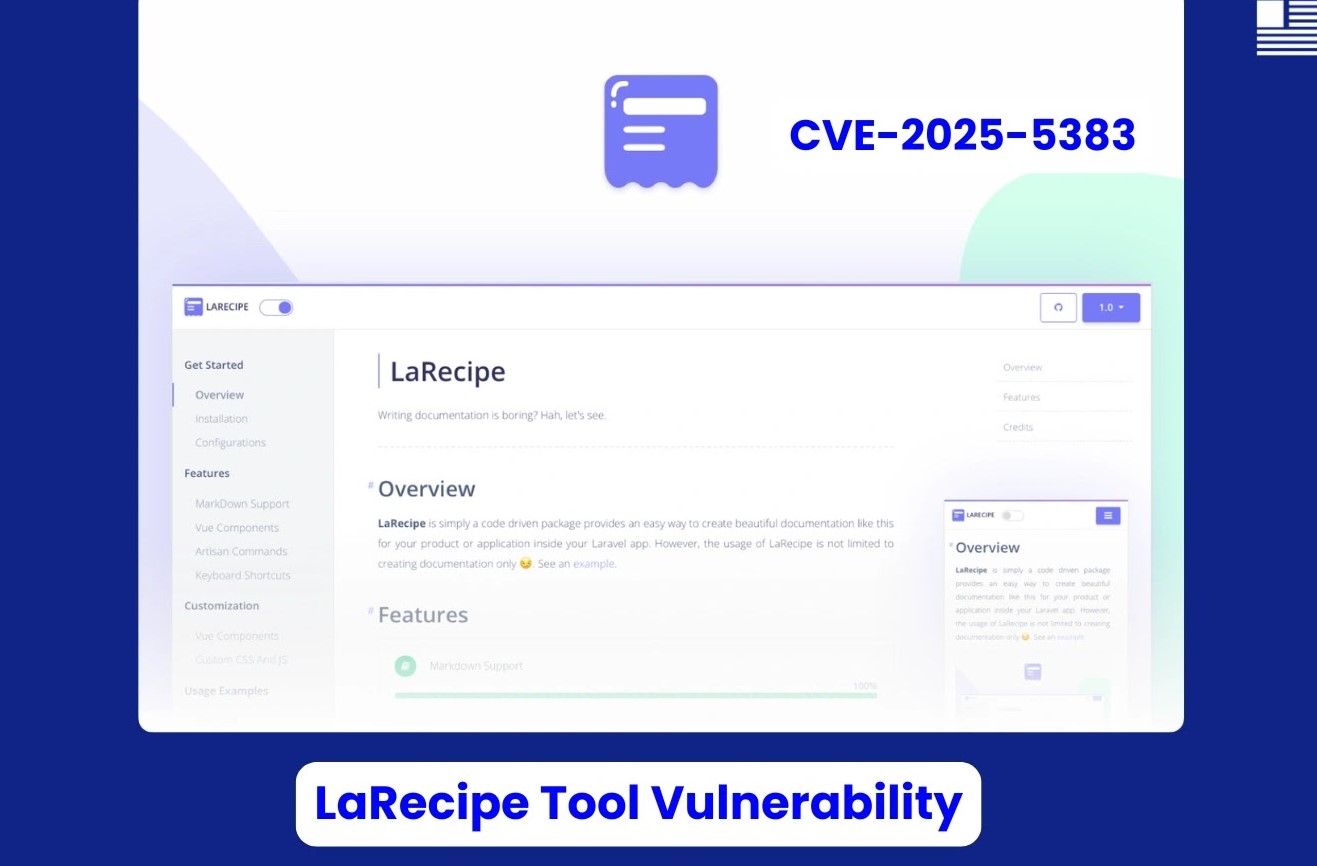
2.3 Million Times Downloaded LaRecipe Tool Vulnerability Let Attackers Take Full Control Of Servers
Unmasking the LaRecipe Vulnerability: A Critical Threat to Server Control
In the expansive realm of software development, tools designed to streamline processes are invaluable. LaRecipe, a popular documentation generator, exemplifies this, boasting over 2.3 million downloads. However, convenience often walks hand-in-hand with potential security risks. A recently unearthed critical vulnerability within LaRecipe (CVE-2025-53833) presents a severe threat, allowing attackers to seize complete control of affected servers. This post delves into the specifics of this flaw, its implications, and the essential steps to mitigate the risk.
Understanding the LaRecipe Critical Flaw: CVE-2025-53833
The core of the LaRecipe vulnerability lies in Server-Side Template Injection (SSTI). This technique allows unauthenticated attackers to inject malicious code into a server’s template engine, tricking it into executing arbitrary commands. In the context of LaRecipe, an attacker could craft a malicious input that, when processed by the tool, would enable them to execute system commands on the underlying server. This level of access grants the attacker the ability to install malware, steal sensitive data, disrupt operations, or even completely compromise the system.
Specifically identified as CVE-2025-53833, this critical flaw affects all versions of the binarytorch/larecipe package. Its widespread adoption, evidenced by 2.3 million downloads, underscores the urgent need for awareness and immediate action from developers and system administrators utilizing this tool.
The Mechanics of Server-Side Template Injection (SSTI)
SSTI vulnerabilities arise when web applications dynamically generate content using server-side templates, but fail to properly sanitize or validate user-supplied input before rendering. Template engines often expose powerful functionalities to enable dynamic content generation. If an attacker can inject their own template syntax into a rendered page, they can leverage these functionalities for malicious purposes, including:
- Accessing sensitive files on the server.
- Executing arbitrary code, leading to Remote Code Execution (RCE).
- Bypassing security controls.
- Escalating privileges.
In the case of LaRecipe, the specific entry point for the SSTI vulnerability has not been publicly detailed, but the outcome is clear: full server compromise is achievable.
Impact and Severity: A Direct Path to Full Server Control
The impact of CVE-2025-53833 is severe. An attacker exploiting this vulnerability can swiftly transition from unauthenticated access to full system compromise. This means:
- Data Exfiltration: Sensitive data stored on the server, including user credentials, proprietary code, or confidential business information, can be stolen.
- System Damage: Files can be deleted, corrupted, or altered, leading to operational disruption or data loss.
- Persistence: Attackers can establish backdoors or install malicious software, ensuring continued access even after initial exploitation.
- Lateral Movement: A compromised server can serve as a jumping-off point to attack other systems within the network.
Given the popularity of LaRecipe, particularly in development environments, the potential for widespread exploitation by malicious actors is significant.
Remediation Actions: Securing Your Systems
Immediate action is crucial to mitigate the risks posed by CVE-2025-53833. Organizations and individual developers using LaRecipe must take the following steps:
- Isolate and Disable: If possible, immediately isolate any systems running vulnerable versions of LaRecipe from public access and internal networks until a patch is applied. If isolation isn’t feasible, disable the LaRecipe instance temporarily.
- Patching/Updating: Monitor the official LaRecipe GitHub repository (binarytorch/larecipe) for the release of a patched version. Update your LaRecipe installation to the latest secure version as soon as it becomes available.
- Input Validation and Sanitization: Implement stringent input validation and sanitization on all user-supplied data, especially anything that could be rendered by a template engine. This is a foundational security practice that can prevent many types of injection attacks.
- Least Privilege Principle: Ensure that the LaRecipe application, and the user it runs under, operates with the absolute minimum necessary privileges. This limits the damage an attacker can inflict even if a vulnerability is exploited.
- Security Audits: Conduct regular security audits and penetration tests on your applications and infrastructure to proactively identify and address vulnerabilities.
- Web Application Firewall (WAF): Deploy a WAF in front of web applications using LaRecipe. A well-configured WAF can help detect and block malicious SSTI attempts.
- Monitor Logs: Implement robust logging and monitoring for your web servers and applications. Look for unusual activity, error messages, or suspicious command execution attempts that could indicate an ongoing attack.
Relevant Tools for Detection and Mitigation
Utilizing appropriate security tools can aid in identifying and preventing SSTI vulnerabilities and other related threats. Below is a table of relevant tools:
| Tool Name | Purpose | Link |
|---|---|---|
| OWASP ZAP (Zed Attack Proxy) | Automated web vulnerability scanner, includes active scanning for injection flaws. | https://www.zaproxy.org/ |
| Burp Suite | Web vulnerability scanner and proxy for manual and automated security testing. | https://portswigger.net/burp |
| Nuclei | Fast and customizable vulnerability scanner with templates for various vulnerability types, including SSTI. | https://nuclei.projectdiscovery.io/ |
| ModSecurity WAF | Open-source web application firewall, can be configured with rulesets (e.g., OWASP CRS) to prevent injection attacks. | https://modsecurity.org/ |
Conclusion: Prioritizing Proactive Security
The CVE-2025-53833 vulnerability in LaRecipe serves as a stark reminder that even widely adopted and trusted tools can harbor critical security flaws. The ability for attackers to achieve full server control through a relatively common technique like SSTI highlights the ongoing importance of secure coding practices, rigorous security testing, and prompt patching. Developers and system administrators must remain vigilant, actively monitor security advisories, and implement a layered security approach to protect their digital assets from evolving threats.





